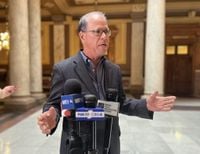Indiana’s political landscape is bracing for a shake-up as Governor Mike Braun intensifies his push for a special legislative session to redraw the state’s congressional district map—a move that could have sweeping implications for the 2026 midterm elections and beyond. Speaking candidly on Fort Wayne’s WOWO radio on September 15, 2025, Braun made it clear that he wants state lawmakers to act swiftly, warning that any delay could bring about “consequences of not working with the Trump administration as tightly as we should,” according to reporting from the Indiana Capital Chronicle.
Braun’s remarks—his clearest yet in support of mid-cycle redistricting—signal a growing urgency among Indiana’s Republican leadership to secure additional GOP seats. The governor, who alone holds the authority to call a special session in Indiana, floated the idea of convening lawmakers as early as November. If that doesn’t happen, redistricting would have to wait until the regular session begins in January 2026, a delay that could complicate the filing period for congressional primaries.
“All I’m telling you is that we’re going to look at [the current maps], we’re going to poll our legislators, and if it’s there, we’re going to do it,” Braun told reporters on September 16. “My feeling is it probably will happen.” He added, “I want it to be where it wasn’t forced upon our legislature, have our leaders talk to their own caucus members. Some have already changed their point of view when they look at what good comes from it. You’re going to find that, probably, the legislators will come around to it. I’m going to give them time. I think eventually we’ll get there.”
The push for redistricting is not happening in a vacuum. The Trump administration is exerting considerable pressure on GOP-led states like Indiana to follow the lead of others—such as Texas, Missouri, Ohio, and Florida—in redrawing congressional boundaries. The goal: to lock in a Republican majority in the U.S. House for the remainder of Trump’s second term. In August, Vice President JD Vance visited the Indiana Statehouse to meet with over 55 Republican legislators, urging them to approve a new map. Later that month, Indiana GOP leaders traveled to Washington, D.C., for further discussions with Vance and federal officials. Trump himself met privately with the heads of the Indiana House and Senate in the Oval Office, according to Politico and the Indiana Capital Chronicle.
Braun has repeatedly tied Indiana’s redistricting timeline to national GOP politics, pointing to Ohio and Florida as examples of states already moving aggressively to redraw their maps. “If we try to drag our feet as a state on it, probably, we’ll have consequences of not working with the Trump administration as tightly as we should,” he reiterated during his radio appearance.
But the governor’s campaign is not without its critics. Julia Vaughn, executive director of Common Cause Indiana, condemned the hardball tactics coming from Washington. “I guess we shouldn’t be shocked that Washington outsiders will do pretty much anything to get Hoosiers to do their political dirty work, but making threats that could hurt Hoosiers who already are hurting? That’s a new low,” Vaughn said in a statement. She emphasized that “multiple polls have shown that a majority of Hoosiers oppose this partisan power grab.”
Opposition is mounting both inside and outside the Statehouse. A coalition of advocacy groups recently delivered nearly 9,000 signatures urging lawmakers not to pursue early redistricting. Meanwhile, Indiana’s Republican supermajorities are still deeply divided. The GOP Senate held a closed-door caucus last week, and House Republicans have been caucusing virtually and in person, but legislative leadership has remained largely silent. Some rank-and-file lawmakers are beginning to shift, however. Seymour Rep. Jim Lucas, for instance, moved from a “hard no to a hell yes” on redistricting, while others like Sen. Spencer Deery of West Lafayette remain opposed to making changes before the next census.
Democratic lawmakers, too, have voiced strong reservations. Rep. Ed DeLaney, D-Indianapolis, described Republican holdouts as “reasonable Republicans” and argued that Braun would need to add other topics to the special session agenda to attract enough support. DeLaney also criticized the notion—floated by some Republicans—that Democrats don’t deserve any congressional seats in Indiana, even though the party regularly garners more than 40% of the statewide vote. Currently, Democrats hold two of Indiana’s nine seats.
Some of the rhetoric has taken a darker turn. U.S. Sen. Jim Banks, a Republican from Indiana, explicitly linked the assassination of conservative activist Charlie Kirk at a Utah college event to the urgency of redistricting. “They killed Charlie Kirk—the least that we can do is go through a legal process and redistrict Indiana into a nine-to-zero map,” Banks told Politico’s Playbook. This comment has only fueled concerns among Democrats and advocacy groups about the motivations and timing behind the redistricting push.
Braun, for his part, has dismissed Democratic criticisms by referencing the state’s maps from two decades ago, which he described as being heavily gerrymandered in favor of Democrats. “I think more and more legislators are understanding that the real gerrymandering—you ought to look at the map that the Dems did from the year 2000, where they were in charge of the new jurisdictions,” he said. “That looked like the tentacles of an octopus, would be the best way to describe it. So you’re going to find, I think, that … (Democrats) are raising most of the chorus against it—because they cannot gerrymander any further.” Notably, the 2000 map was bipartisan: Democrats controlled the House and Governor’s Office, but Republicans held the Senate.
Financial considerations are also in play. Special sessions in Indiana are not cheap—a two-week session in 2022 cost taxpayers about $240,000, according to the Indiana Capital Chronicle. The potential November session could carry a similar price tag, raising questions about the fiscal prudence of convening lawmakers solely for redistricting. Braun has hinted that if a special session is called, legislators could take up other issues as well, since they are not confined to a single topic once in session.
As the debate intensifies, the stakes for Indiana—and for national politics—are clear. Redistricting is typically conducted only after the decennial census, but the current effort is part of a broader national movement among both Republicans and Democrats to redraw maps in key states ahead of the 2026 midterms. In Texas, for example, Republicans recently passed a congressional map that could net the party five additional House seats, while Democrats in Illinois and Maryland are pursuing similar strategies to fortify their own positions.
For now, all eyes are on Governor Braun and the Indiana General Assembly. Will lawmakers heed the call for a November special session and redraw the state’s political boundaries? Or will mounting opposition, both from within the legislature and among the public, force a pause until the regular session in January? The answer could shape Indiana’s—and perhaps the nation’s—political future for years to come.




